AMD's Phenom Unveiled: A Somber Farewell to K8
by Anand Lal Shimpi on November 19, 2007 1:25 AM EST- Posted in
- CPUs
3D Rendering Performance
We'll start off our look at 3D rendering performance with the latest version of Cinebench, we ran the single and multi-threaded benchmarks and reported the scores below:
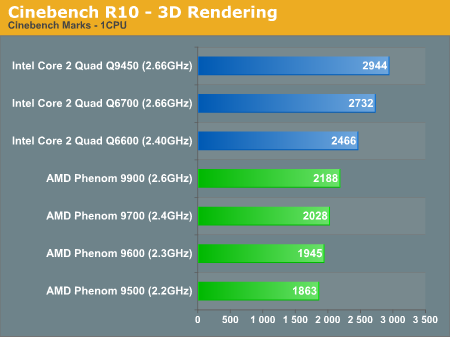

Single threaded performance goes to Intel, highlighting a theme you've probably already noticed thus far: Core 2 is far more efficient per clock than Phenom. AMD would need to be at around 2.8 - 2.9GHz to equal the performance of the Core 2 at 2.4GHz in this particular benchmark, even the Phenom 9900 can't cut it.
Looking at the multi-threaded results we see that AMD does gain some ground, but the standings remain unchanged: Intel can't be beat. We can actually answer one more question using the Cinebench results, and that is whether or not AMD's "true" quad-core (as in four cores on a single die) actually has a tangible performance advantage to Intel's quad-core (two dual-core die on a single package).
If we look at the improvement these chips get from running the multi-threaded benchmark, all of the Phenom cores go up in performance by around 3.79x, while all the Intel processors improve by around 3.53x. There's a definite scaling advantage (~7%), but it's not enough to overcome the inherent architectural advantages of the Core 2 processors.
3dsmax 9
As always we have our 3dsmax 9 test, using SPECapc's 3dsmax 8 benchmark files. The numbers we're reporting below are strictly the CPU rendering composite scores:
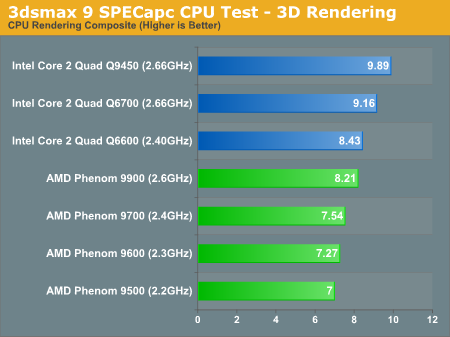
Here the Phenom 9900 is basically as fast as the Core 2 Q6600, unfortunately for AMD the 9900 doesn't launch until next year and it will launch at a price greater than the Q6600. AMD needs help cutting prices fast if it expects Phenom to remain competitive in the eyes of everyone who doesn't own a Socket-AM2 motherboard.
Lightwave 9.5
We see a similar story in our Lightwave benchmarks, the Phenom 9900 at best can equal the performance of the Q6600 but at worst it looks like AMD needs another 200 - 300MHz to catch up to Intel's cheapest quad-core:
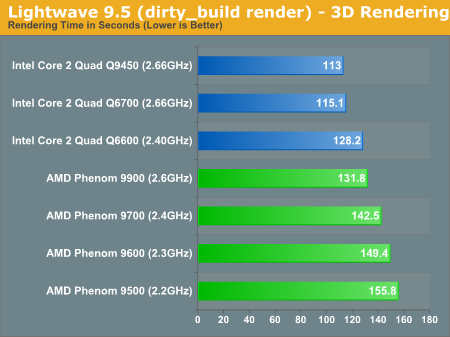
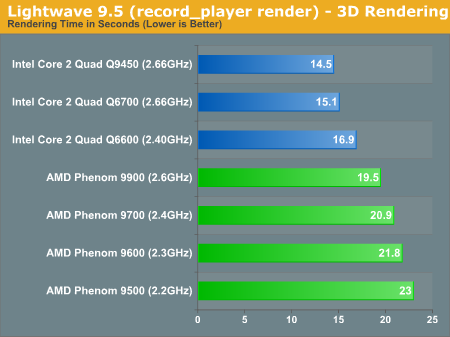
POV-Ray
The POV-Ray benchmark is quite possibly the least kind to AMD out of the group:
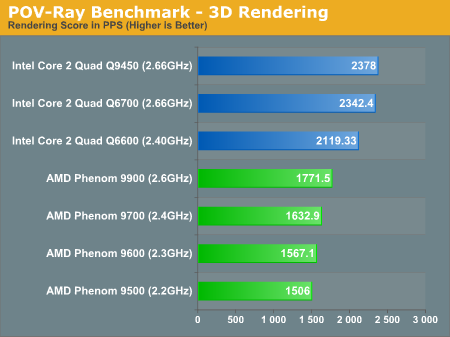
Intel's Q6600 is 20% faster than AMD's fastest Phenom due out in Q1, it's 30% faster than Phenom at the same clock speed, and 35% faster at the most competitive price point.










124 Comments
View All Comments
strikeback03 - Wednesday, November 21, 2007 - link
I wondered too, but I guess they figured the newest AMD chipset was most appropriate for the test. Seeing as availability there is shady as well, there aren't many options. Not sure why they didn't choose a cheaper Intel board and DDR2 (since no DDR3 for AMD) but at those speeds their tests don't seem to show much extra performance for DDR3 over DDR2 anyway.newuser2 - Wednesday, November 21, 2007 - link
As I thought I was wrong with memory pricing (it was 274 not 560) so we have $609 vs $301 if now I'm right.haylui - Wednesday, November 21, 2007 - link
Hopefully IPC improved Shanghai are doing flawlessly in AMD's R&D Lab now. Phenom is worth buy when their TLB errata and quickly ramp up to 3GHz stable cpu.Quad CF is something attractive to hardcore high end gamers when Phenom 9 series can come out something at 3GHz that are able to give some really competition to Intel's Penryn and Kentsfield.
Lithotech - Tuesday, November 20, 2007 - link
AMD's OverDrive Utility looks very good, and extremely exciting to hear it actually works. nTune's screens are much larger when sized big enough that there are no scroll bars on the screen, something that's annoyed the carp out of me since it's release. While I do have a couple high res displays, most of the stations in my workshop have only 1024x768 or 1280x1024. I very much like how AMD has designed the interface, and look forward to trying it some time soon.Other thoughts:
There is no doubt good value in these new quad cores.
Monitary value if and when AMD cuts pricing -- if the last year is any indication of their commitment to this, we may see much more than just sub $200 quads. For mid-range parts, these processors are plenty fast and any mainstream user would be plenty happy using one. The non overclocker does not consider how much headroom is in a CPU and the fact that the Intel equivelents will clock much faster than AMD's parts is completely nullified. It gets right back to basics: price. The overclocking community is growing fast however, and it's nice to see both AMD and Intel recognizing a dedicated and loyal clientel by releasing the Black Editions and showcasing that new chip of Intels.
Value in technological advancement -- AMD doubtless needs Phenom core technology, and accompanying chipset and socket technology in order to evolve into the next generation. Like Formula 1 racing (or any racing for that matter), not moving forward in technological development equates to moving backwards because if you are standing still, everyone else is passing you. AMD has/is learning a tough lesson in letting the competition catch up as they coasted for so long with the Athlon64.
Value in power savings -- Each core is independant, and can be clocked at different speeds?! CoolnQuiet on 2 cores, the other two happily crunching full speed in some game? Lower overall temperatures in the end? Oh yeah, baybuh, watch the Silent PC enthusiasts and HTPC builders flock to this!
Value in reduced spoilage -- one core out of four not quite up to snuff? Disable it and bin the part as a Tri-Core CPU at rediculously attractive prices! In the end, less waste means lower costs to us all as the overall cost of all the products will be greatly reduced. Over time, less spoils per wafer will doubtlessly be achieved, but by then we should see spoiled and binned 8-core CPUs appearing as 6-core, 5-core, 7-core, maybe even 4-core! This is a tough thing for Intel to match untill they get their quads all on one die.
.
extraflamey22 - Wednesday, November 21, 2007 - link
Are people just completely ignoring the fact that the listed Phenom prices are PER 1,000? There's no way you'll be able to buy a $280 2.3GHz Phenom at "launch" (if you can find a retailer who has them in stock).Also, the Q6600 is a completely fictional product, and can't be bought from Newegg retail for $279.00 USD. This is why people are pointing to the Phenom as the clear price/performance leader. *boggle*
While I'm glad AMD fans can find some redemption in Phenom by pointing to the inevitable price cut, this is incredibly short-sighted. Simply put, AMD CANNOT AFFORD to play the margin-slashing game with Intel forever. Phenom needed to *destroy* the Q6600. That would have given AMD the ability to charge a performance premium, and start MAKING MONEY. High-end Phenoms would have been great chips to bridge the gap in performance between the ridiculously priced Extreme chips and the Q6600 (and be priced accordingly), but instead it's outperformed by chips over a year old, and has difficulty keeping up with the still amazing Athlon 64s (albeit in single-threaded apps, but still...)
Kyle at was exactly right, AMD needed to launch a high-end 3GHz part, and bin down to 2.2GHz to fill out the processor family. They did not do this, and are in trouble.
I was really hoping AMD could come out with something special, and gain some much needed market share.
Right now it's clear Intel is holding back (whether to soak up profits or in fear of completely destroying AMD and bringing anti-trust/monopoly investigations down on their heads... or both... is dependant on how you spin it) and a revitalized AMD would have kicked Intel into high gear, bringing advances to the market and the end-consumer faster and lower-priced.
I really hope AMD gets over it's yield issues FAST, and is bolstered by sales of it's Spider platform, but overall this is bad news for the industry. Competition pushes technology forward, and while Intel's tick-tock cycle (and frankly the necessity for Intel to compete against it's own previous-gen products, if nothing else) will keep moving us forward, no one doubts a stronger AMD would have pushed both companies to bigger and better things.
strikeback03 - Wednesday, November 21, 2007 - link
[quote] Also, the Q6600 is a completely fictional product, and can't be bought from Newegg retail for $279.00 USD. [/quote]not sure what you mean by that. http://www.newegg.com/Product/Product.aspx?Item=N8...">http://www.newegg.com/Product/Product.aspx?Item=N8...
a product known as the Q6600 for $279.99 in stock. Guess they were off by 99 cents.
extraflamey22 - Wednesday, November 21, 2007 - link
Sorry, I thought my sarcasm was pretty clear (hence, *boggle*), but apparently it's not transparent enough.I posted that because I kept reading posts over and over from people saying the Phenom has the best price/performance ratio. It clearly does not. I simply wanted to emphasize that based on the initial pricing from AMD, the Q6600 is a huge problem for the Phenom, as it's simply the much better buy.
My apologies.
strikeback03 - Wednesday, November 21, 2007 - link
The rest of your post was sensible, so I was not sure if you were joking or not.Wasn't boggle a board game?
extraflamey22 - Thursday, November 22, 2007 - link
As a matter of fact, it is a board game. I use it as short-hand for "that just boggles the mind...(i.e. doesn't make sense)", which may or may not be common usage, but hey, it's how I talk. :)lectrolyte - Tuesday, November 20, 2007 - link
Hi,First time posting here, I've noticed that no one has made any comment about the power useage of the processors. The claim that the Intel processor is more efficient at idle is only telling half the story and is misleading.
Intel has quiet clearly claimed the performance crown with the core 2 duo but anyone who has been following the direction of the industry over the last couple of years will notice that performance is not as much of an issue as it used to be. Even a three year old processor can quite happily perform most everyday tasks, qed performance is no longer king.
Alot of effort is being placed into efficiency and performance per a watt. Evidence of this can be seen from VIA still being alive and well selling it's C7 processors, the growth of AMD in the datacentre and the growth of dual core chips.
I wont say that the phenom is a stellar peformer it's not, but if you look at the improvements that have been made to it you will notice that most of them centre around power management and efficiency.
back to my original point, comparing the power draw of only the processors at idle is incompentant at best and deliberately misleading at worst due to the fact that the memory controller is build onto the chip of the phenom. You really need to see the power draw of the system at full load compared to make any reasonable assumptions.
Consider that quad cores are more likely to end up in a data centre than a home system in the near future and that for every 1w of energy dissipated by your computer you will be spending ~1.5w to keep it cool and then Phenom starts to become much more interesting, add the extra memory bandwidth and native quad cores and I think you will find the performance gaps start to close a little bit on sevrer oriented applications (obviously this statement is conjecture, i'd really like to see some comparrisions of server-type loads if anyone has them but i suspect the differences would be much smaller than shown on end user loads)